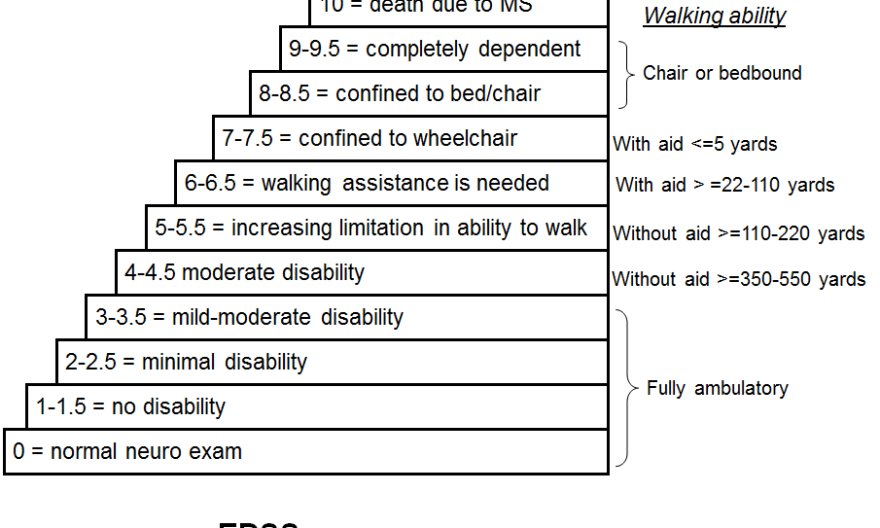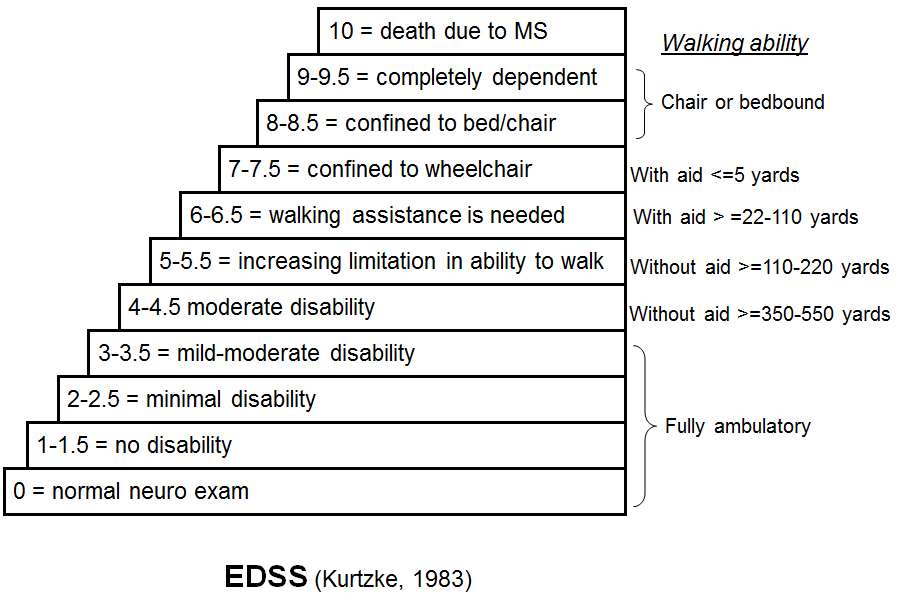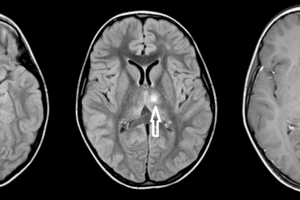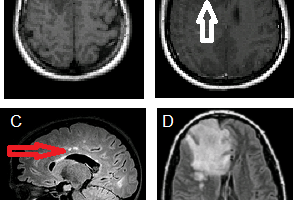
Disability progression is assessed by the Expanded Disability Status Score (EDSS). To make sense of the scale from 0 (normal neuro exam) to 10 (death due to MS), a few pointers:
- 1-1.5 is no disability that the patient notes, e.g. decreased vibration sense or red desaturation
- 3-3.5, billed as “disability is mild to moderate,” but clinically this is already significant disease
- 5-5.5, “increasing limition in ability to walk” is a rarely used class in clinic because outside of trials, it may not be practical to measure precise walking ability and distance
- 6-6.5 in practice means needs a walker
- 7-7.5 means confined to wheelchair and is the cut-off for most clinical trials

Download the EDSS assessment form.
EDSS
The language used here is modified from the full EDSS form linked above.
0.0 – Normal neurological exam.
1.0 – No disability, minimal signs in one functional system (i.e., grade 1).
1.5 – No disability, minimal signs in more than one functional system*.
2.0 – Minimal disability in one functional system.
2.5 – Minimal disability in two functional systems.
3.0 – Moderate disability in one functional system or mild disability in three or four functional systems though fully ambulatory.
3.5 – Fully ambulatory but with moderate disability in one functional system and one or two functional systems grade 2; or two functional systems grade 3 or five grade 2.
4.0 – Fully ambulatory without aid, self-sufficient, up and about some 12 hours a day despite relatively severe disability consisting of one functional system grade 4, or combination of lesser grades exceeding limits of previous steps; able to walk without aid or rest some 500 meters.
4.5 – Fully ambulatory without aid, up and about much of the day, able to work a full day, may otherwise have some limitation of full activity or require minimal assistance; characterized by relatively severe disability usually consisting of one functional system grade 4 or combinations of lesser grades exceeding limits of previous steps; able to walk without aid or rest some 300 meters.
5.0 – Ambulatory without aid or rest for about 200 meters; disability severe enough to impair full daily activities (e.g., to work a full day without special provisions).
5.5 – Ambulatory without aid for about 100 meters; disability severe enough to preclude full daily activities.
6.0 – Intermittent or unilateral constant assistance (cane, crutch, brace) required to walk about 100 meters with or without resting.
6.5 – Constant bilateral assistance (canes, crutches, braces) required to walk about 20 meters without resting.
7.0 – Unable to walk beyond approximately 5 meters even with aid, essentially restricted to wheelchair; wheels self in standard wheelchair and transfers alone; up and about in wheelchair some 12 hours a day.
7.5 – Unable to take more than a few steps; restricted to wheelchair; may need aid in transfer; wheels self but cannot carry on in standard wheelchair a full day; May require motorized wheelchair.
8.0 – Essentially restricted to bed or chair or perambulated in wheelchair, but may be out of bed itself much of the day; retains many self-care functions; generally has effective use of arms.
8.5 – Essentially restricted to bed much of day; has some effective use of arm(s); retains some self-care functions
9.0 – Helpless bed patient; can communicate and eat.
9.5 – Totally helpless bed patient; unable to communicate effectively or eat/swallow.
10.0 – Death due to MS.
Reference
Kurtzke JF. Rating neurologic impairment in multiple sclerosis: an expanded disability status scale (EDSS). Neurology. 1983 Nov;33(11):1444-52.


